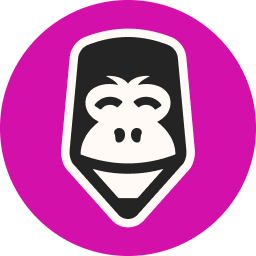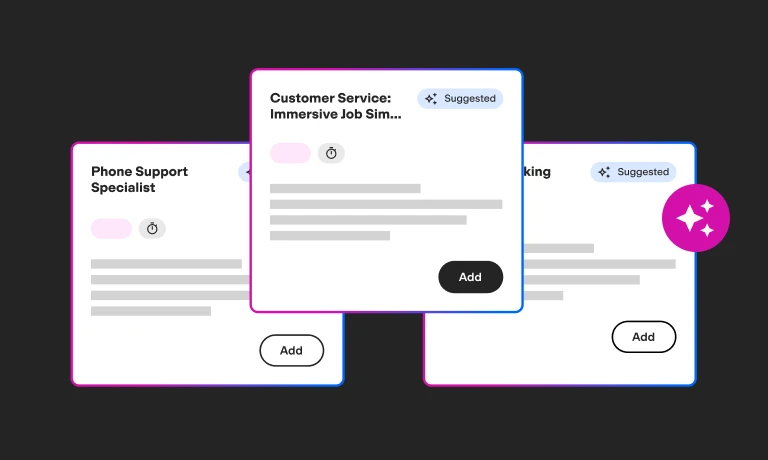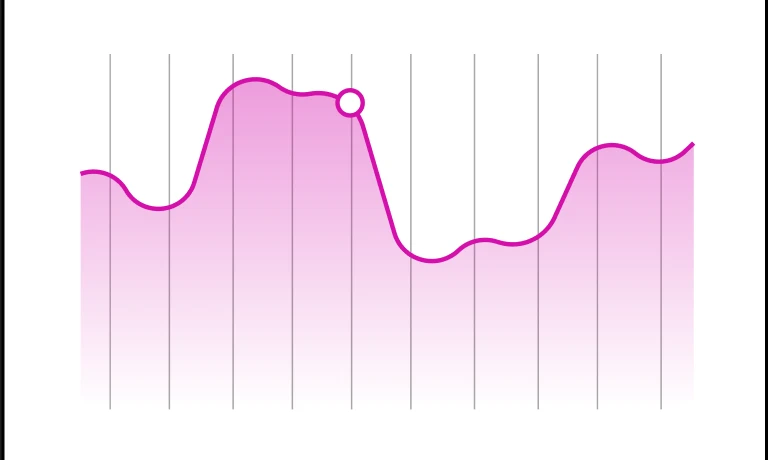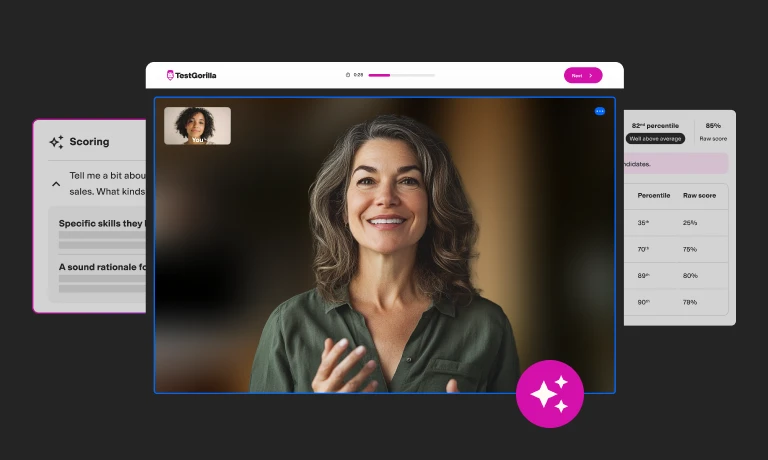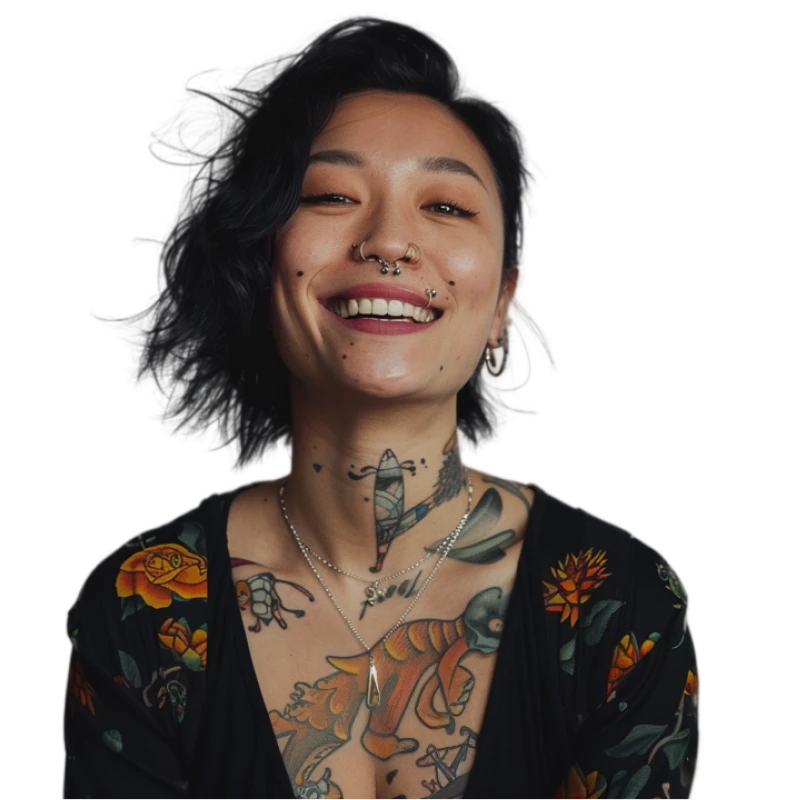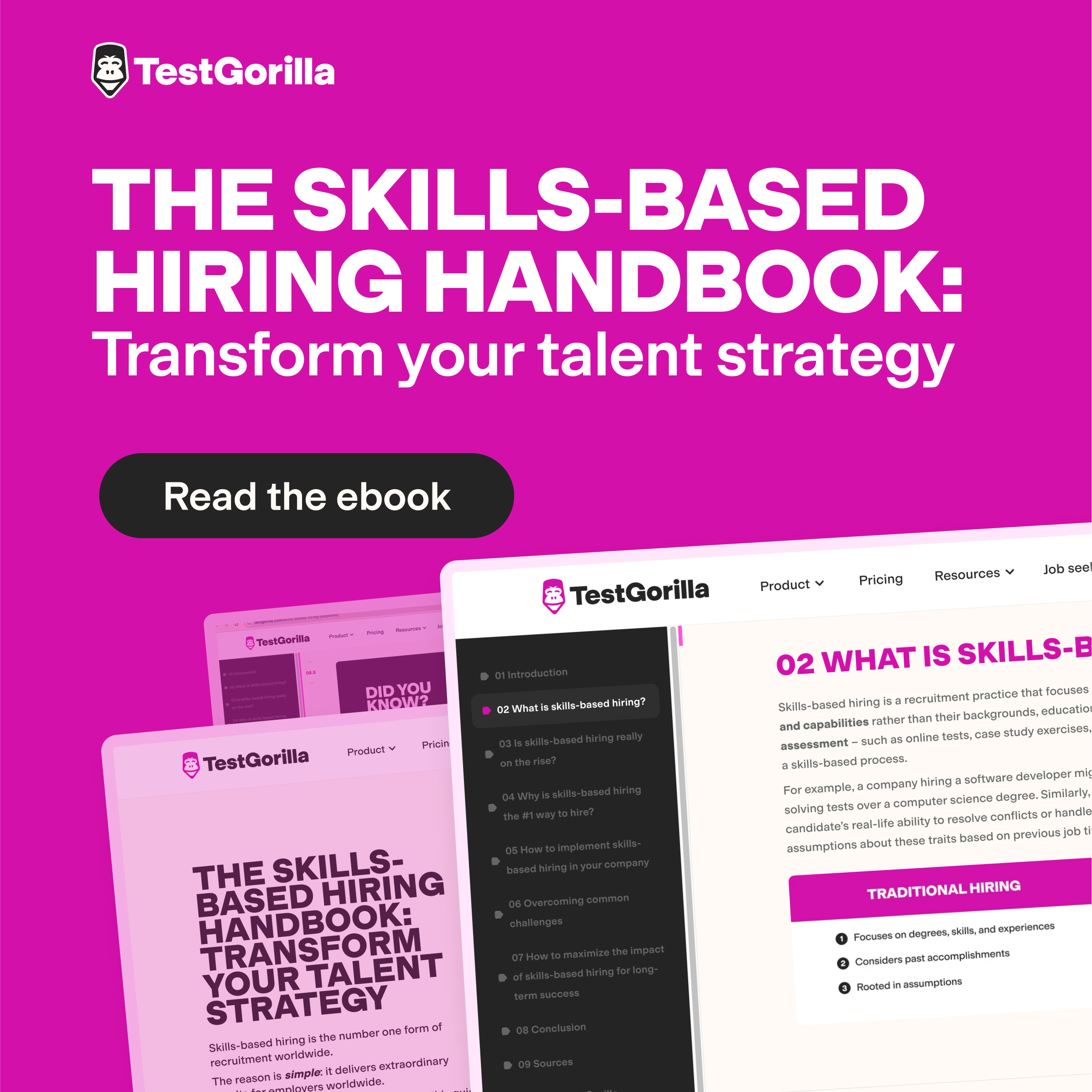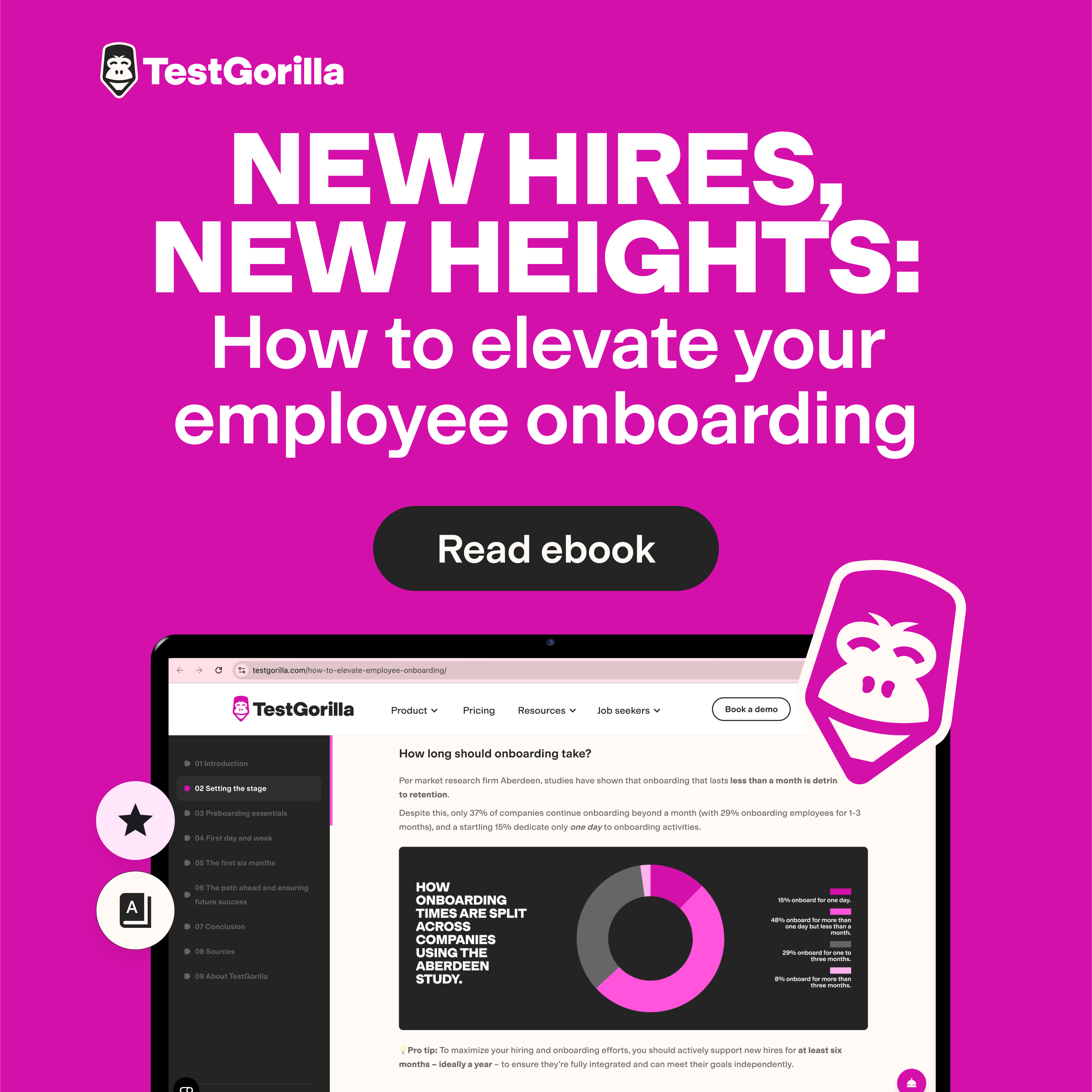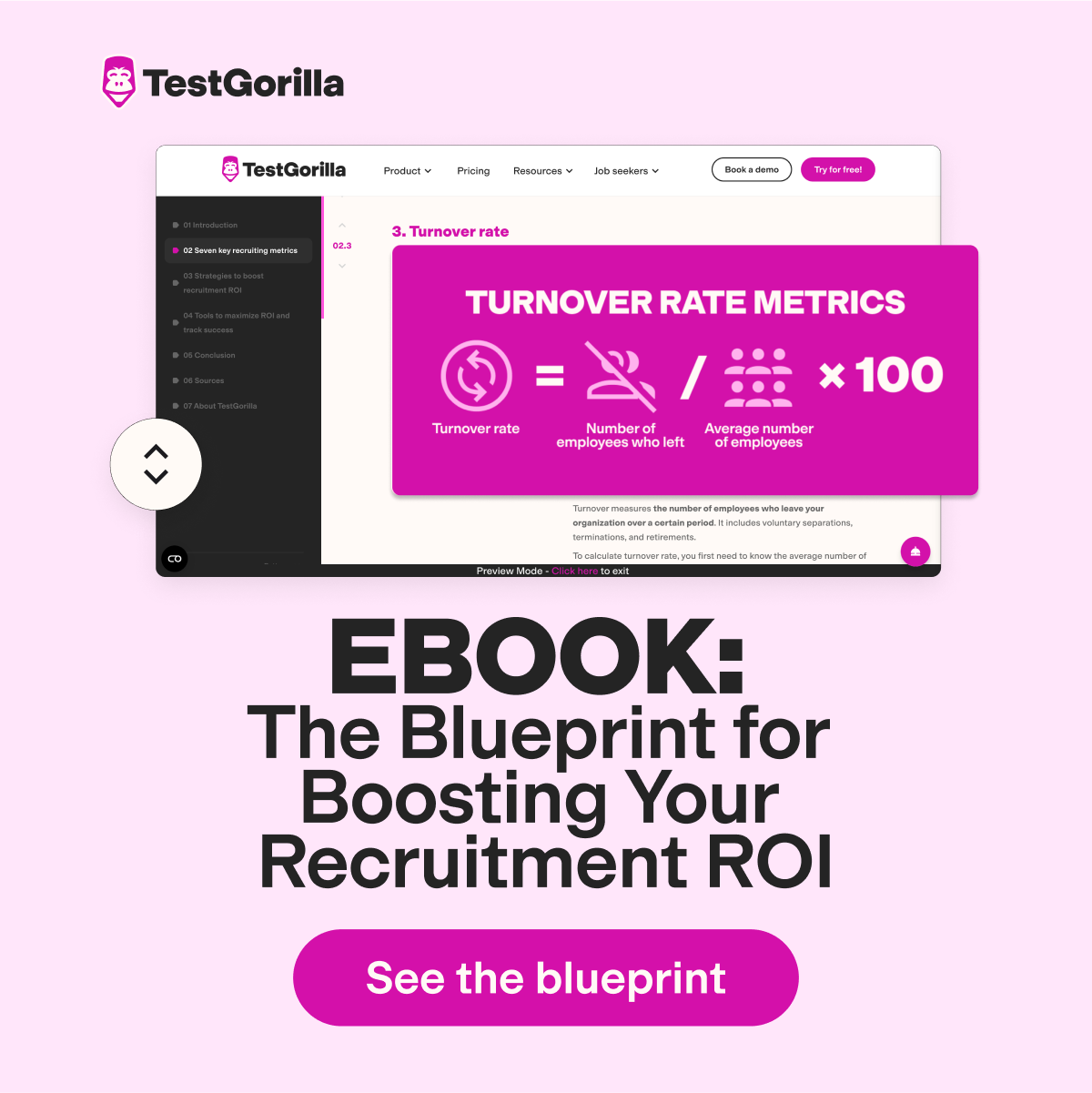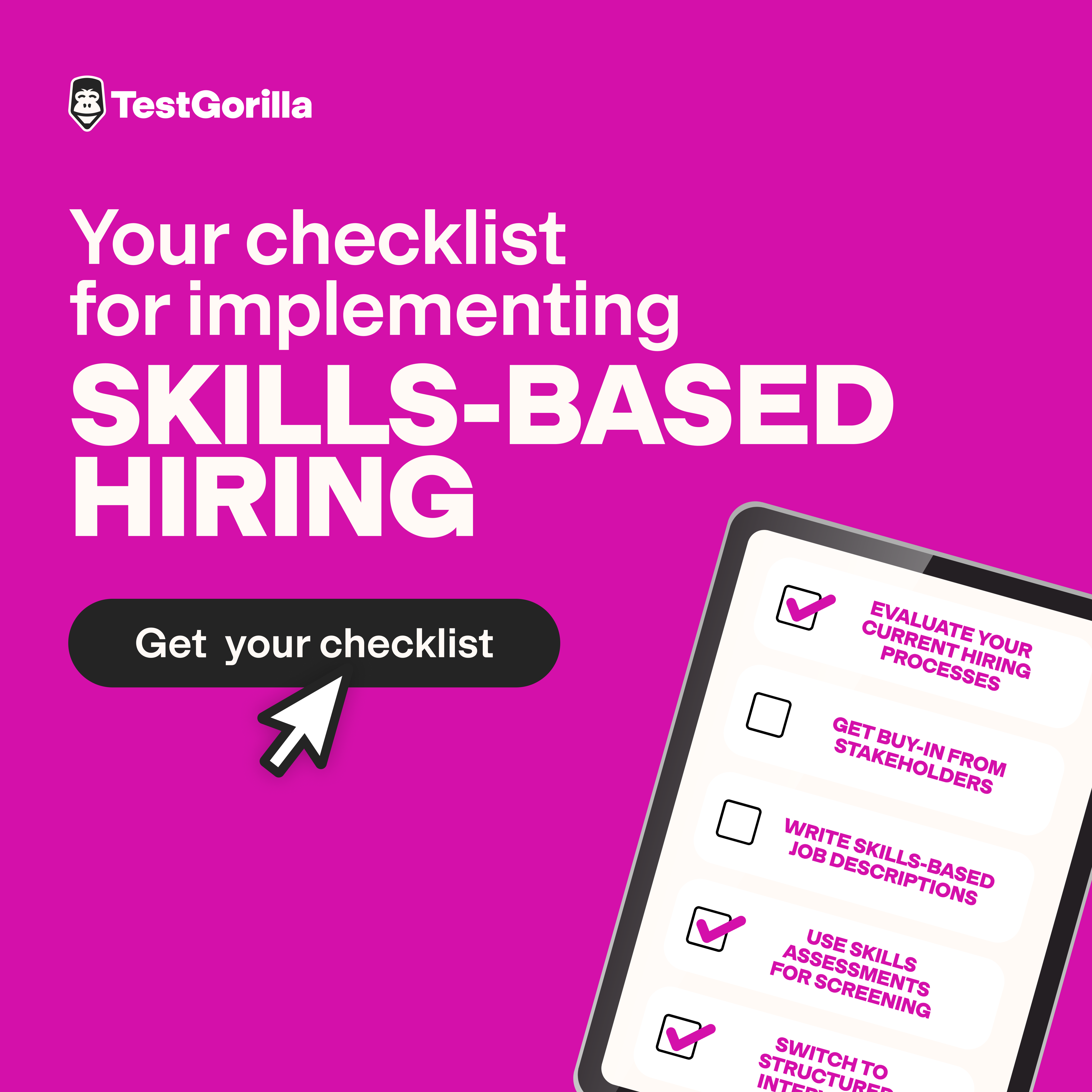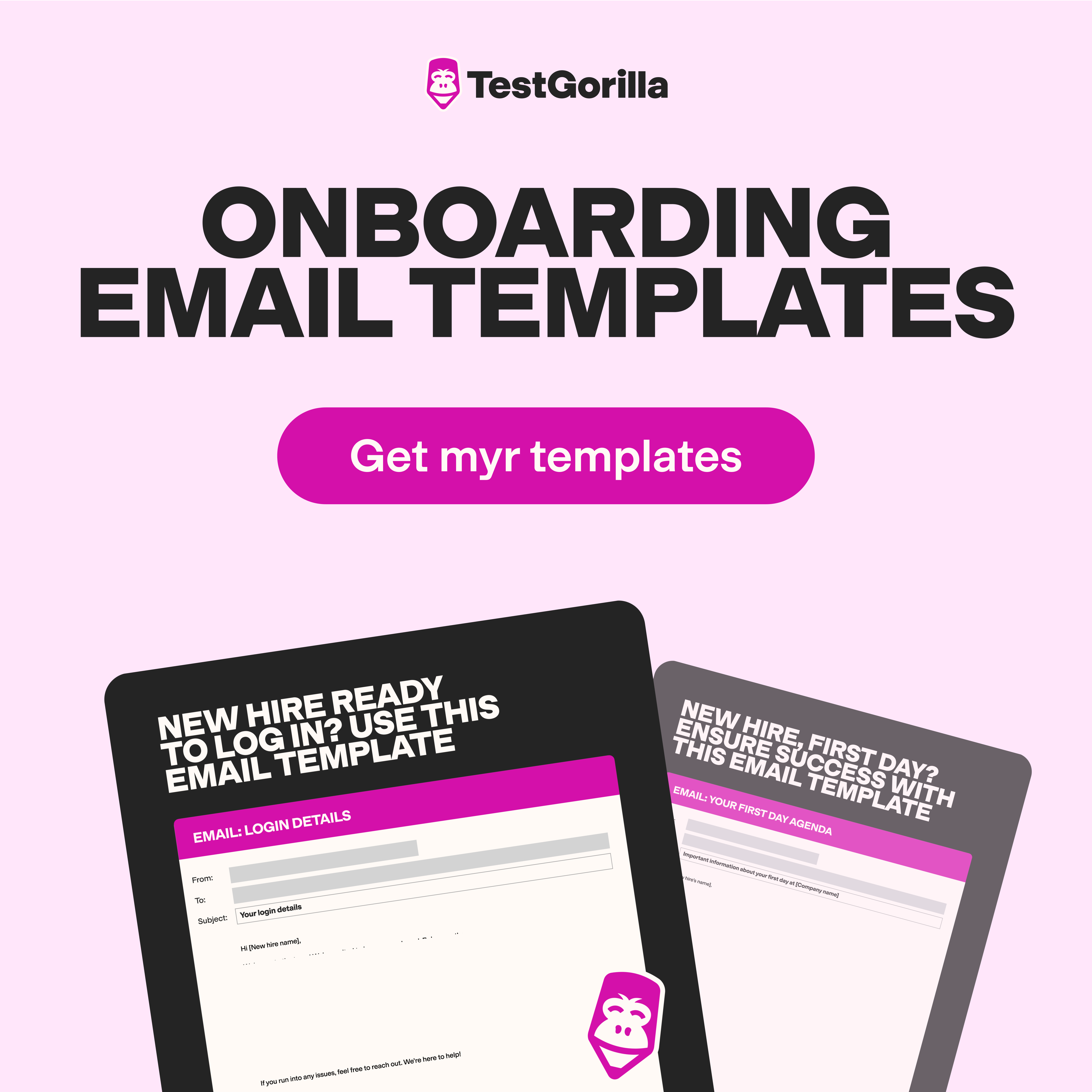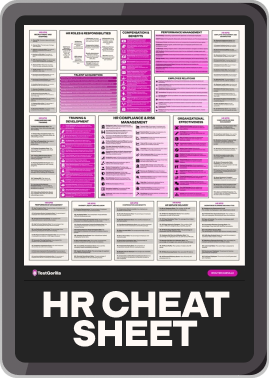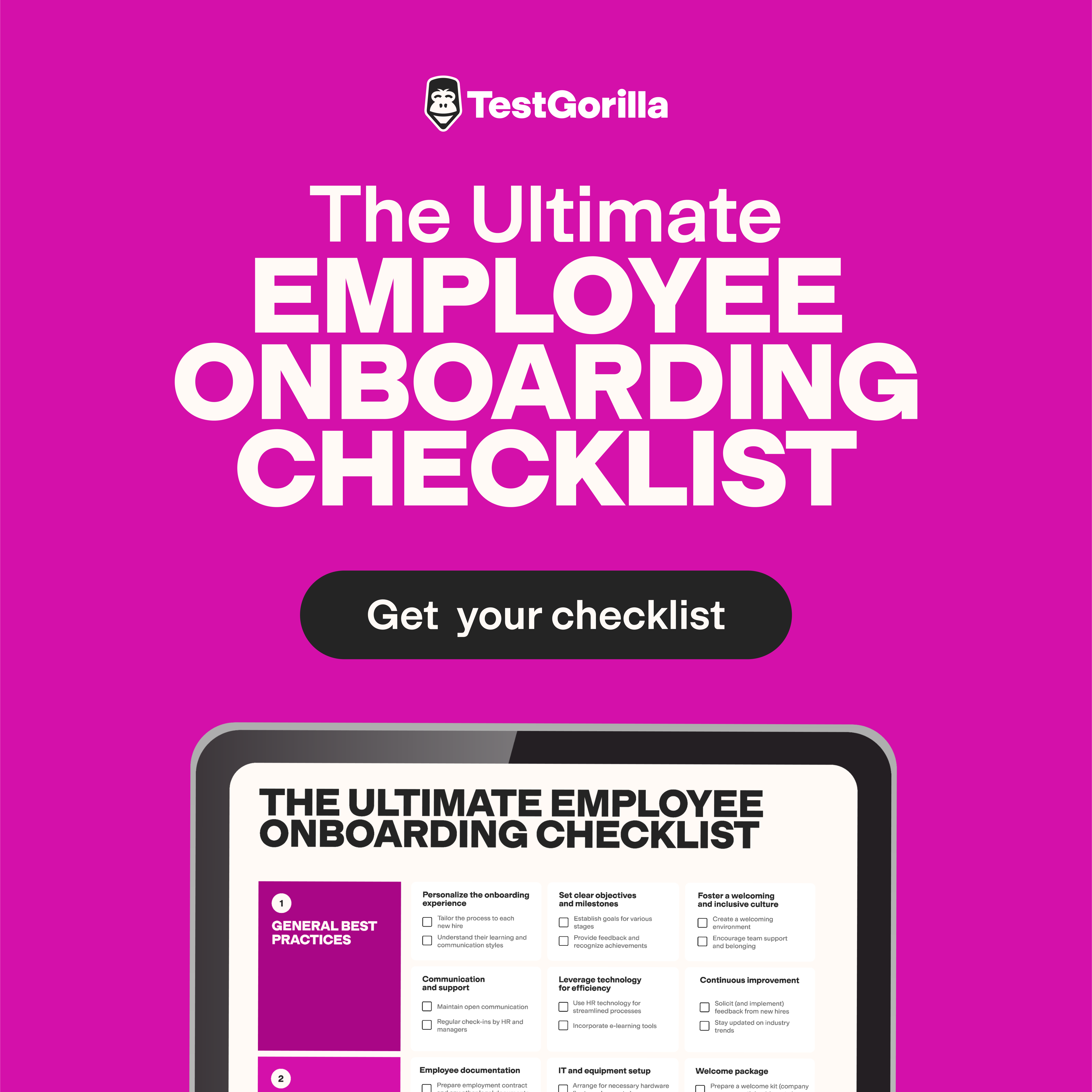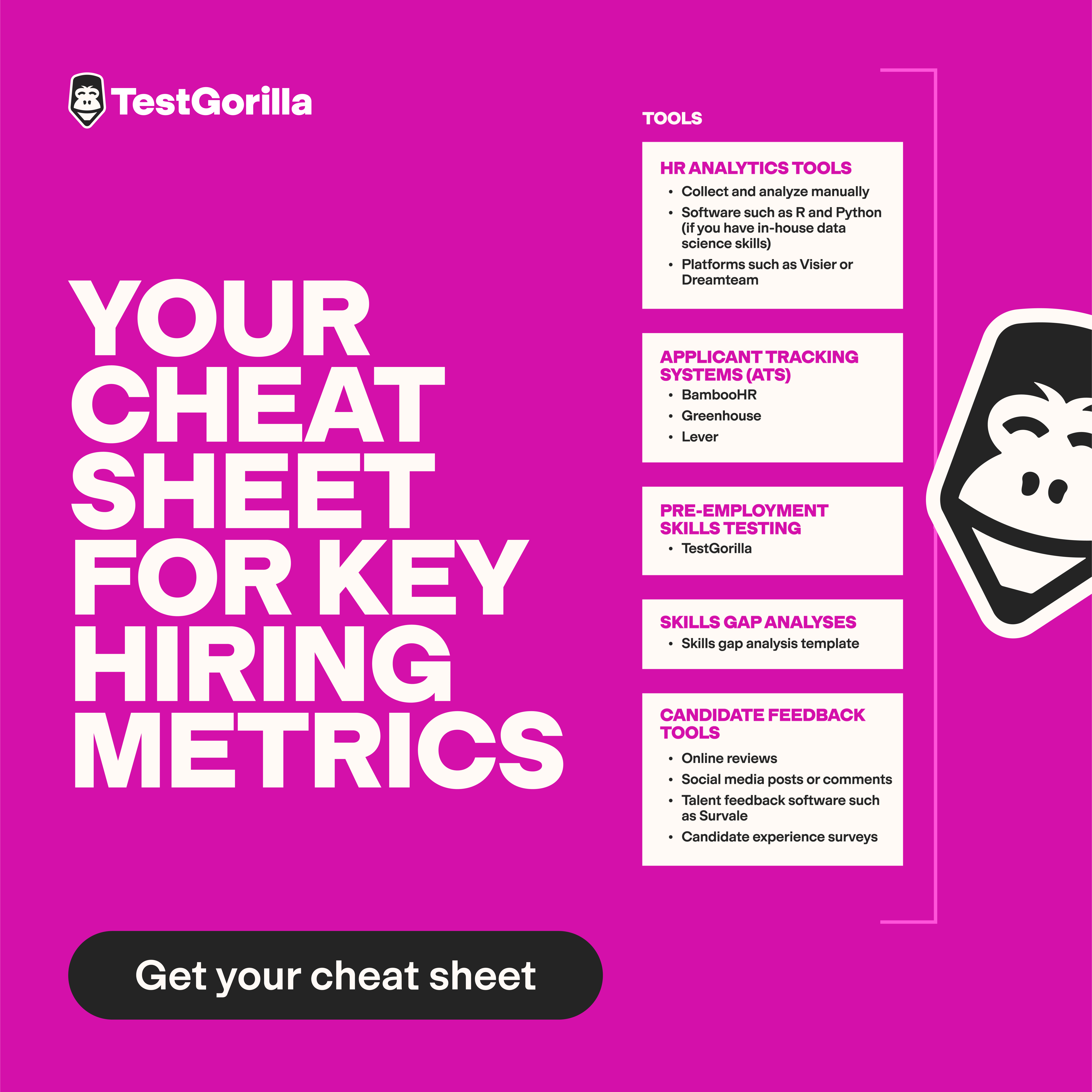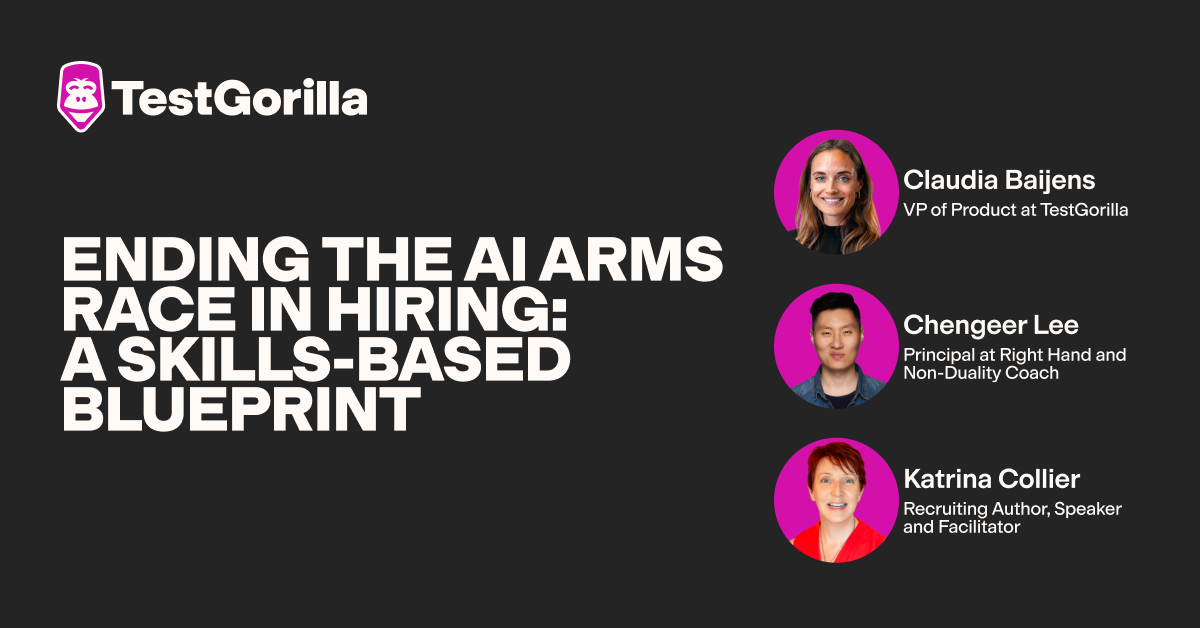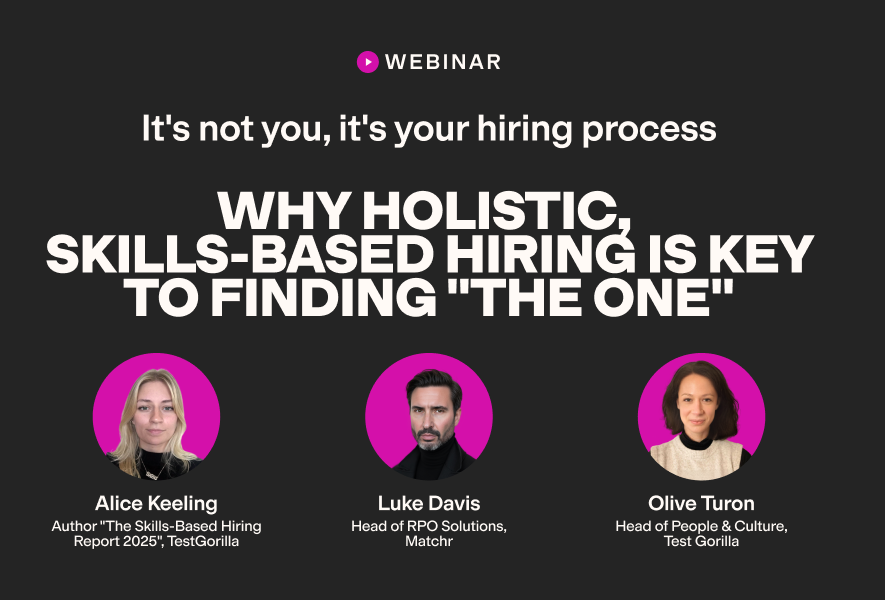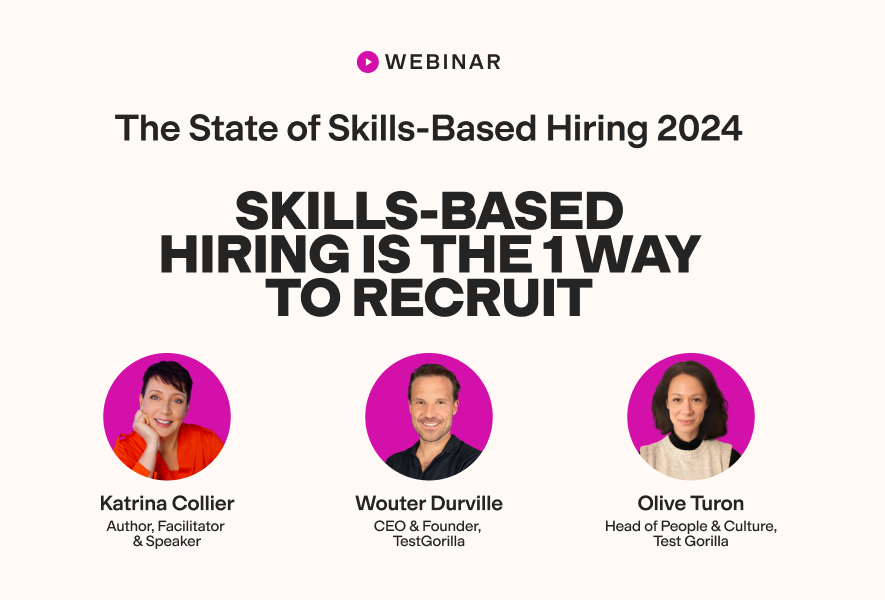44 graphic design interview questions
The right designer can help you complete projects efficiently while aligning your brand’s message with the right design. The wrong person, however, can destroy your efforts to create a good first impression with potential customers. For this reason, asking your candidates the right graphic design interview questions is critical.
But too many companies ask too many of the same questions – overly focusing on certain topics at the expense of others.
Luckily, we can help. Below, we share seven categories of graphic design interview questions to help you hire a graphic designer – or other design professional – with the skills and qualities you need.
Table of contents
- 5 general graphic design interview questions
- 16 graphic design interview questions related to technical knowledge and ability
- 5 graphic design interview questions related to achievements and work ethic
- 6 graphic design interview questions related to adaptability
- 4 graphic design interview questions related to time management
- 5 graphic design interview questions related to communication and collaboration
- 3 graphic design interview questions related to planning processes
- 5 tips for interviewing graphic designers
- Hire the best graphic designer for your business by using the right interview questions
5 general graphic design interview questions
Here are five general graphic design interview questions you can ask candidates to learn about their background and knowledge.
1. Why did you choose a career in graphic design?
Sample answer:
My passion for design has been evident since I was young. My favorite hobby was sketching and drawing; people always said I was very creative. I decided to become a graphic designer to harness and develop this creativity.
Graphic design enables me to help my clients reach their target audience by sharing underlying brand messages through design. That’s why I opted for a bachelor’s degree in graphic design and, later, built a rewarding graphic design career.
2. How would you define graphic design?
Sample answer:
I’d say that graphic design is all about creating unique designs that make a lasting impression on customers and resonate deeply with them. It combines strategic marketing, planning, and storytelling to help brands connect with their customers.
Design projects might include advertising for a company, creating packaging designs for products, or creating web design concepts.
3. What skills do good designers have?
Sample answer:
Good designers need a strong mix of both soft skills and hard skills.
Communication skills are essential, as we typically work with clients, marketers, and developers to make decisions. We need to be able to handle feedback constructively – whether from a creative director or a client who wants to make changes. Good time management is important, especially when working on multiple projects or working on tight deadlines for agencies.
On the technical side, we must be knowledgeable about tools like Adobe Illustrator, Photoshop, or Figma and how to use hierarchy, color, and spacing principles to address user and business needs.
4. What are your strategies for staying up to date on the latest graphic design trends?
Sample answer:
To stay current with the latest graphic design technology and trends, I read online magazines like Smashing Magazine and Creative Bloq. I also stay active on design platforms like Dribbble and Behance to get updates and inspiration from my peers.
Additionally, I take online courses when new technology is released. This is particularly important, as lots of AI-powered features have become available to designers now, and they’re essential for optimizing workflows. I take free courses on YouTube or pay for courses on Udemy.
5. How do you stay inspired and keep coming up with creative ideas?
Sample answer:
I have several ways to stay inspired and come up with new ideas.
I revisit my old work to remember what my design perspectives used to be.
I follow designers on social media sites, like Instagram and Pinterest.
I communicate with designers on graphic design platforms like Dribbble and Behance.
I follow creatives in related fields like photography and architecture for inspiration.
I look at what top competitors are doing to see what is working and which ideas might fit in with the brand I’m working with.
16 graphic design interview questions related to technical knowledge and ability
The following 16 graphic design interview questions are focused on technical skills. Use them to learn whether your candidates have the right technical skills for your open position.
1. What is UX design? Could you provide an example of appealing UX?
Sample answer:
UX design is about making software user-friendly and enjoyable to use. This is achieved through testing and researching the best ways for users to complete different tasks on your website. These include common tasks like searching for items, finding contact information, or completing a purchase – UX design is about making these as painless as possible.
An example of good UX design would be the Zara website, which uses a simple, minimalist design. Its search bar and navigation menu are easy to find, and its central image dominates the page. The logo is bold and contrasts with the white background.
Check out our article on UX interview questions for more questions like this one.
2. What is visual design, and what do visual designers do?
Sample answer:
Visual design is about creating the overall look and feel of a product or brand. Visual designers blend elements like typography, layout, color, logos, and imagery to develop cohesive and recognizable designs.
Unlike graphics designers, who focus mainly on individual, static designs, visual designers are more holistic. For them, creating consistency across multiple touchpoints is key.
*Discover our guide to hiring a visual designer.
3. How is UX design different from visual design?
Sample answer:
UX design is focused on user flows – how a user gets from A to B and completes all the tasks they want to – without being focused on how the product looks. Visual design focuses only on how a product looks and feels. This is why visual designers often work with UX designers to create a complete product.
Simply put, UX design is about function, while visual design is about fashion.
4. Which are the primary types of graphic design projects?
Sample answer:
There are five main types of graphic design projects:
Graphic design projects for exterior/environmental spaces
Digital design and UI/UX design
Projects that involve in-motion elements, such as a presentation
Advertising and marketing design
Product design
5. Which design software do you prefer to use?
Sample answer:
For me, this depends on the project that needs to be completed. For instance, although I can use Sketch and Adobe Photoshop and I’m comfortable using a wide range of design software, I prefer to use After Effects if the project has an animation element, as it’s ideal for text animation and implementing visual effects.
In contrast, if the project is more focused on website design (whether UX or UI), Figma has become the industry standard, so using Figma makes it easier to work with design and development teams across these projects.
6. Which design software are you most experienced with?
Sample answer:
In addition to Adobe Creative Cloud, which I use to enhance the styles of web pages using CSS, I also know how to use Adobe Illustrator, OneNote, Publisher, and Captivate. I use Captivate to transfer PowerPoint files into a format suitable for the Web, which is one of its advantages: it makes it easier to upload presentation files.
7. Can you name some components that are crucial in graphic design?
Sample answer:
There are seven critical components in graphic design:
Color (and color theory)
Texture
Typography (and how it relates to the design)
Shape
Line
Space
Scale
8. Explain the importance of three of these components (of your choice). Why are they essential?
Sample answer:
Using color theory can help brands connect with their target audience and enhance their brand image.
Line components are essential for leading the eye towards the information you wish to communicate or focus on, and scale refers to how big the design elements are, in order to draw attention to them or divert the eye to other elements, depending on their size.
9. Can you describe what the lasso tool in Photoshop does?
Sample answer:
The lasso tool is used to highlight areas of an image that don’t have a regular shape (like a rectangle or circle). With these images, you must freehand the edges. The tool is often used to cut elements out of an image, mask areas on a graphic, or refine sections for more detailed edits.
There are a couple of variations of the lasso tool, like the polygonal lasso for areas with straight edges and the magnetic lasso, which automatically snaps to the edges of highly contrasting image elements.
10. Can you name some of the composition rules that graphic designers should use in their projects?
Sample answer:
I use four different composition guidelines when creating a design:
The golden ratio: This is a mathematical ratio of approximately 1:1.6, which commonly appears in nature, art, and architecture. This design technique creates balance in layouts by naturally dividing space. I use it to design ratios for logos, buttons, and icons.
Alignment: This is also about creating visual harmony, but unlike the golden ratio, alignment focuses on how separate elements are arranged together. Whether elements are vertically or horizontally aligned, careful placement is crucial because even slight misalignments can make designs feel unprofessional.
Proximity: This rule is about placing related elements closer together to show they have related functions. For example, you’d group a heading with its paragraph to show they’re related. This improves clarity and hierarchy, as users can instantly see what belongs together.
White space: Sometimes called negative space, this refers to the blank areas of a design. While the space is empty, it’s not wasted. White space helps improve readability and creates focus for important elements on the screen. It also keeps the design clean and prevents it from feeling cluttered and messy.
11. How is JavaScript used for graphic design projects? How would you incorporate it into your process?
Sample answer:
I don’t work directly with JavaScript as a designer, but designers must understand what JavaScript can do. Our designs are often brought to life by front-end developers who use JavaScript. Each computer programming language has its strengths and limitations, and as designers, we must know that what we design can be achieved by the programming language.
This means I keep JavaScript’s capabilities in mind during the design phase. I even use modern design tools like Figma, which are built with the capabilities of JavaScript in mind – so a JavaScript developer can easily implement everything I create in there.
12. In computer-aided design, how do non-associative and associative hatching differ?
Sample answer:
The difference between non-associative and associative hatching is that associative hatching lets you alter contours while the hatch automatically fills them. In non-associative hatching, this doesn’t occur.
Whereas the crashes in automatic computer-aided design can impact a design or drawing in associative hatching, non-associative hatching doesn’t have these problems.
13. Explain what 3-dimensional graphic art is.
Sample answer:
3-dimensional graphic art helps designers create animation for digital purposes that is suitable for backgrounds or landscapes. The 3-dimensional models facilitate the process of spatial visualization, enabling designers to see details that would be impossible to see otherwise.
14. Can you explain some of the concepts that are critical in digital design?
Sample answer:
With digital design, I always keep in mind the following: not only should the design be easy to navigate, but it should also be tested and previewed on different devices.
Despite being intangible, the design can (and should) be viewed before being finalized, so paying attention to the quality of the image and its resolution (pixels per inch) is important.
15. Can you explain some of the concepts that are critical when designing for print?
Sample answer:
With print design, you can’t change the final product, which is the main difference between print and digital. Other factors can affect the design, such as the texture of the paper that is used. In this case, paying attention to the dots per inch is important.
16. What is color theory?
Sample answer:
Color theory involves selecting the right combination of colors from the palette or color wheel while ensuring they match the client’s brand.
What’s also important is that color can help you communicate the brand’s message, and since human optical ability, psychology, and culture all influence how we interpret colors and brands, choosing the right color is crucial.
The best insights on HR and recruitment, delivered to your inbox.
Biweekly updates. No spam. Unsubscribe any time.
5 graphic design interview questions related to achievements and work ethic
Ask your candidates the following five graphic design interview questions to learn about their professional experience, work ethic, and achievements.
1. What do you consider to be your best graphic design project? Why?
Sample answer:
The best graphic design project I’ve worked on was at Company XYZ.
The original webpage had a poor flow between elements and didn’t provide a smooth user experience. I used alignment, white space, and color strategically to lead the eye to the crucial parts of the webpage. This improved conversions and reduced the bounce rate twofold.
I used Dreamweaver to manage the webpage, which helped me make corrections throughout the process and visualize the end result.
2. Can you name a project that you found challenging? What made it difficult?
Sample answer:
In my previous role, I was tasked with a logo redesign that came with a number of very specific requirements. I had to retain the essence of the brand but give the logo a touch of creativity to match the new digital book publishing services offered by Company ABC.
I kept the logo simple with a solution that retained the color scheme of the brand and used the same theme. Since the company specialized in publishing, I retained the book jacket concept but altered the typography to give it a modern twist.
The client was delighted with the logo and mentioned that I had captured the essence of the company and their products.
3. How would you evaluate whether your design is successful?
Sample answer:
There are a few criteria that I use to determine whether my designs are successful. The first is looking into the return on investment (ROI), or analyzing the data to see the financial impact of my design. This might be through increased traffic or purchases.
I also consider whether the design speaks to my audience and look to see if customer engagement has increased.
Finally, I check to see whether there was an uptick in conversion or retention rates.
4. Have you ever made any errors on a graphic design project? What would you do differently now?
Sample answer:
At the beginning of my career, I had to redesign a logo for a company that sold beverages. My mistake was using various fonts instead of sticking to a unified font that would have better carried the message of the brand.
Looking back, despite asking a few initial questions, I probably could have communicated more efficiently with the brand owner to clarify the crux of the brand message. I’ve since implemented a more efficient communication process to gather requirements.
5. What do you hope to achieve in the next two years?
Sample answer:
Within the next two years, I hope to have gained a lot of experience with complex design projects that will help me advance within your company. I’d like to take on high-profile clients going forward and deepen my knowledge of various design software tools to help me achieve my goals.
6 graphic design interview questions related to adaptability
Use the questions below to evaluate whether your candidates can adapt to new tools, teams, and processes.
1. What’s your process for getting familiar with new design software?
Sample answer:
I think regular practice combined with research is crucial.
My first goal would be to learn more about the key features of the design program. To upskill and gain knowledge on how to use the software, I’d practice using the program independently while working on my own projects.
2. What would you do if you received negative feedback from a client after submitting your design?
Sample answer:
I recognize that logo, Web, print, and animated design all have an element of subjectivity.
For this reason, I’d make sure I understand the client’s feedback and try to balance what they’re looking for with my creative ideas. Working together with clients is important, and I’d use clarifying questions to learn exactly what the client would like to adjust in order to create a design that’s in line with their vision.
3. Have you ever disagreed with a client’s feedback? How did you respond?
Sample answer:
In my previous role, once I received negative feedback that I didn’t agree with. I thought that the pamphlet I had designed mirrored the brand of the company, a fine art gallery; it used calligraphy-style typography and the brand’s color scheme.
The owner decided that the style wasn’t appropriate for their brand. Although I didn’t see eye to eye, I acknowledged the feedback and made some adjustments to incorporate it into the final design. Graphic design is subjective, after all.
4. What’s your process when you start working on a new graphic design project?
Sample answer:
When I start working on a new graphic design project, I ask as many questions as I can to clarify the brief. I always ask what the client’s vision for the project is and what success would look like, in terms of specific features and elements.
Since I recognize that the client’s vision is of crucial importance and that alignment with the brand is key, I try to gain a solid understanding of the brand identity in order to be able to incorporate it in my work.
5. Have you ever had to make significant changes to a project while working on it? Explain how you made the changes.
Sample answer:
Despite my ability to interpret design briefs well and ask clarifying questions as needed, on one occasion, one of my clients suggested that the webpage I had designed wasn’t aligned with the brand. They didn’t like the typography I had chosen.
Although I thought the typography reflected Company 123’s brand (it was a finance and banking company and I had chosen a bold typeface with plenty of white space), the client requested that I vary the font.
We decided to make changes, and I incorporated his ideas by asking a few questions to further clarify the brief. The final result reflected the client’s goals and vision.
6. Have you ever found it difficult to come up with ways to improve a project?
Sample answer:
Towards the beginning of my career, I struggled to come up with creative ways to improve one of my first projects. The brief was to develop a print newsletter for a borough council. I wasn’t sure how the final version would turn out due to the textural elements of the design.
Since I wasn’t sure how to improve it, I asked for some advice about the paper it would be printed on. In the end, the newsletter was a success because the textural elements worked well with the specific type of paper that was used.
4 graphic design interview questions related to time management
Here are four graphic design interview questions you can use to evaluate your candidates’ time management skills.
1. How do you cope with tight deadlines?
Sample answer:
My main approach with tight deadlines is to organize my time efficiently when putting my ideas together.
I create estimates for myself by focusing on pre-defined milestones and breaking the project down into smaller, achievable goals. If it’s clear that I won’t meet the next milestone’s deadline, I always let the team know that I need some help.
2. What is your approach to task prioritization when working on different projects?
Sample answer:
On one occasion, I had to handle two tasks at the same time. I had to begin working on one project while implementing feedback from a client on another project. I created daily to-do lists and used blocks of time that I dedicated to each project.
I’m able to shift comfortably between projects since I create a list of required tasks and order them by their priority and importance. After that, I define my daily schedule and allot time for each task. This way, both the high-priority and low-priority tasks get completed on time.
3. Why is time management important?
Sample answer:
For me, time management is essential, as it helps me ensure I stay on top of all tasks that I need to complete. Thanks to my solid time management skills, which I developed in the past years, my work is less stressful and I can give my clients accurate estimates for the time I need to complete a given project.
Although there might be a tendency to get absorbed by projects and carried away by creative exploration, I try to always stay on track and complete all projects on time.
4. Describe a time when you missed a project deadline. How did you adjust your design process after that?
Sample answer:
In my previous role, I missed a project deadline because I didn’t factor in the length of time it’d take to incorporate a minor change a client requested. The margins and white space of the newsletter I had designed were not big enough, so this project carried over to the following day.
I have since learned to focus on time management as a skill. I read blogs and articles that give graphic designers advice on how to manage time more efficiently. Subsequent projects were delivered on time and well received.
5 graphic design interview questions related to communication and collaboration
Use these five graphic design communication and collaboration interview questions to evaluate your candidates’ teamwork skills.
1. Why is communication critical when completing graphic design projects?
Sample answer:
In my opinion, communication is critical not only for understanding and discussing design briefs but also for making changes, incorporating feedback, and requesting support from others when working with tight deadlines.
Frequent communication with the team is essential, and regular check-ins with my clients help align my creativity with their vision. It also helps me share the underlying brand messages effectively and make sure it meets the clients’ needs.
2. What are your strategies for working in a team to execute a design project?
Sample answer:
I always use active listening when working as part of a team because this helps ensure that everyone’s creative ideas get heard.
An essential part of team collaboration, for me, is understanding the feedback provided by team members on design projects. Therefore, a key part of my strategy is to ask clarifying questions to understand others’ feedback, discuss different approaches, and then implement changes.
3. Do you prefer to work as part of a team or independently?
Sample answer:
Over the course of my career, I’ve worked with various teams and had multiple solo design projects. Both work styles present difficulties and have their advantages.
Even though communication difficulties can occur when working with others, I prefer to work as part of a team, because it allows you to bounce ideas off one another, manage time more efficiently, and offer each other advice.
4. How would you describe a top design team?
Sample answer:
I work best with teams that are highly collaborative, communicate efficiently, seek feedback from each other, and support each other to complete projects.
Since I’ve worked in large teams, I know that communication is crucial, as is using the right communication tools. I’ve worked in smaller teams, too, and I’m quite flexible.
5. How do you work with cross-functional teams on bigger projects?
Sample answer:
For me, efficient communication is critical when working as part of a cross-functional team. Communication must be clear, timely, and transparent.
I like to gather ideas from the marketing team as well as the UX design team to help me make progress, and I try to establish common goals by communicating efficiently with each team, so that we’re all on the same page.
3 graphic design interview questions related to planning processes
You can evaluate your graphic design candidates’ planning process by asking them these three questions below.
1. What is your process when executing a project?
Sample answer:
I use four key strategies when carrying out a design project. First, I research the project and try to learn as much as I can about the brand. I ask several questions and use active listening to understand the design brief.
Second, I plan. I incorporate various milestones to break up the project into smaller tasks and ensure I stay on track.
Third, I manage my time with different task prioritization techniques. I write lists that correspond to each milestone and put the tasks in order, based on their importance, urgency, and the internal logic of the project.
Finally, I begin working on the project and incorporate any team/client feedback as I move towards its completion.
2. What questions do you ask clients when you start a new project?
Sample answer:
Three questions I ask clients when beginning a new project are:
Which are the key values you wish to communicate to your audience?
What is your target audience?
What is your goal and vision for this design project?
What would be a clear indicator of success?
With these four questions, I’m able to align the client’s vision, audience, and my own objectives as a designer to complete the project efficiently.
3. How would you approach a design project that doesn’t have a clear brief?
Sample answer:
Since understanding the project’s brief is essential for ensuring the right brand message is communicated to the audience, I always ask additional questions to ensure I know what is required.
I try to learn about the culture of the company and its brand image, and ask about the specific style and features that the client expects to see in the final design.
5 tips for interviewing graphic designers
To make the most of your interviews when recruiting a graphic designer, there are a few best practices to keep in mind.
Below, you can find our top five tips for interviewing graphic designers:
Use pre-employment skills assessments. Pre-employment skills assessments are best used before the interview stage, as they help you identify your most talented candidates and limit biases. Use skills tests to evaluate your candidates’ strengths and shortlist your best applicants efficiently.
Use structured interviews to further limit unconscious bias. Unconscious bias, for example recency bias or gender bias, can hinder your chances of hiring the right candidate. Structured interviews can help you minimize unconscious bias during hiring, especially when combined with skills tests.
Always use open questions. With closed interview questions, you risk receiving short answers that don’t give you enough information about your candidates’ skills. To learn more about your applicants’ experience, use open questions, or ask follow-up questions.
Choose the right amount of time for the role. If you’re hiring a junior graphic designer, you might need less time for the interview than if you’re hiring for a senior position. Always give all candidates an equal amount of time to answer your questions.
Invert the interview process. Letting candidates ask you questions is also important. It’ll reveal how motivated they are to join your organization and help you enhance the candidate experience. Invert the interview process to let your candidates learn more about your organization.
Hire the best graphic designer for your business by using the right interview questions
The right interview questions are important and can enhance both the interview process and the candidate experience. The questions above will help you prepare for the interview stage and get an in-depth understanding of the skills and experience of your applicants.
Remember to always adapt your questions to the requirements of the role to discover whether your candidates have the right skills and hire top graphic designers for your team.
With TestGorilla, you’ll find the recruitment process for graphic designers to be simpler, faster, and much more effective. We offer various tests – including our Adobe Illustrator test or a UI/UX Design test – that you can use to screen applicants and shortlist top-ranking candidates to interview.
Get started for free today and start making better hiring decisions.
You've scrolled this far
Why not try TestGorilla for free, and see what happens when you put skills first.

